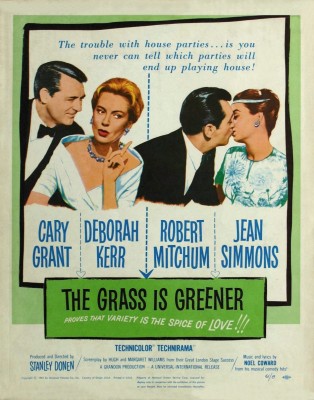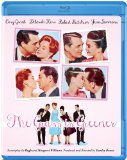| Reviews & Columns |
|
Reviews DVD TV on DVD Blu-ray 4K UHD International DVDs In Theaters Reviews by Studio Video Games Features Collector Series DVDs Easter Egg Database Interviews DVD Talk Radio Feature Articles Columns Anime Talk DVD Savant Horror DVDs The M.O.D. Squad Art House HD Talk Silent DVD
|
DVD Talk Forum |
|
|
| Resources |
|
DVD Price Search Customer Service #'s RCE Info Links |
|
Columns
|
|
|
Grass is Greener, The
So why is it that The Grass Is Greener one of the most lifeless, excruciatingly inert movies ever made?
That's a tough nut to crack, but mainly two reasons. It can't shake its extreme staginess, for one. And among the capable, charismatic leads two are badly miscast, unable to overcome parts to which they're just not suited. The latter problem was largely the result of much last-minute reshuffling of parts.
The picture was produced independently in Britain by Grandon, Cary Grant and Stanley Donen's partnership, which had previously made Indiscreet (1958). Universal-International handled the U.S. release, but the rights have since changed hands and now the film resides with Paramount. They, in turn, sublicensed it to Olive Films.
Their Blu-ray edition is merely okay. The movie was photographed in Technirama, a process similar to VistaVision but with the addition of an anamorphic lens rendering a screen shape similar to CinemaScope but, because the exposed film area was twice as large, the resultant image normally would be considerably sharper and steadier. The potential is there for a transfer as gorgeous as, say, the Blu-rays of The Music Man, Circus World or Zulu, but it's only marginally better than the average late ‘50s/early ‘60s CinemaScope/Panavision film in high-def. No extras.
Cary Grant and Deborah Kerr play impoverished British aristocrats, Victor, Earl of Rhyall, and Lady Hilary. To maintain their cavernous estate they raise mushrooms and open their house to busloads of tourists. Sellers (Moray Watson, later George Frobisher on Rumpole of the Bailey), their butler, is employed mainly to impress the tourists and complains he has no work to do. Victor and Hilary love one another but are equally bored.
One tourist, American millionaire Charles Delacro (Robert Mitchum), wanders into a private part of the house, a room where Hilary is working. Initially she's annoyed by his obvious and intentional disregard of the house rules, but he sweeps her off her feet and the two are locked in an embrace within a matter of minutes. Victor wanders in and at once suspects them, suspicions confirmed when Hilary spends several days away in London. There, she has a rendezvous with Charles at the Savoy, while Victor stews at home, deciding he'd rather wait it out, hoping she'll tire of Charles and return home.
Meanwhile, Victor's flamboyant, eccentric ex-girlfriend Hattie (Jean Simmons) pays her old boyfriend a visit, deriving pleasure divulging various sordid details of the illicit romance.
Grant and Donen bought the film rights to the 1958 play, which starred Hugh Williams, Celia Johnson, Edward Underdown, and Joan Greenwood in the roles played in the film by Grant, Kerr, Mitchum, and Simmons, respectively. Moray Watson, as Sellers, was the only carry-over from the West End production.
For the film version, Grant was originally supposed to play Victor but felt the role ill-suited him. Subsequently, the roles of Victor and Hilary were offered to Rex Harrison and his real-life wife, Kay Kendall, with Grant now intending to play Charles, the role eventually portrayed by Robert Mitchum, and with Deborah Kerr set to play Hattie, the role eventually portrayed by Jean Simmons.
Kendall, however, was dying from myeloid leukemia, though Harrison and others convinced her that she was merely suffering from an iron deficiency. Her condition grew worse, and both actors dropped out. After briefly considering replacing Kendall with Ingrid Bergman, the decision was made to have Grant and Kerr play Victor and Hilary, with newly cast Mitchum and Simmons in the Charles and Hattie roles. (If nothing else, it reunited Kerr with Grant and Mitchum, her third movie which each man.)
Grant plays a subdued form of his familiar screen persona, but he's all wrong as a traditional English lord, jealous but too passive to take direct action against his wandering wife. The dialogue is crisp, cynical, and witty, but just doesn't work coming out of Grant's mouth. Squint and imagine Rex Harrison in the part and there's a world of difference.
Likewise, flamboyant, eccentric Hattie is too much a stretch for Jean Simmons, who by this time was known for dignified, lady-like parts. Kerr, with a similar screen image (From Here to Eternity notwithstanding) might have been equally inapt, though Kerr could get pretty jocular when the part called for it (as in the original Casino Royale). But Joan Greenwood, from the stage production, virtually defined the term English eccentric, would have been spot-on, and was (just) a big enough name they probably could have used her. I wonder why they didn't?
Stanley Donen, one of the greats, tries his best to liven things up, including a funny, expertly choreographed split-screen shot that must have been incredibly difficult to pull off so well. He takes his players on long dolly shots outside the estate, briefly to London, etc., but nothing helps, and though sometimes the lines are funny, the 105-minute feature moves at a snail's pace.
Video & Audio
As noted above, Olive's 2.35:1 video transfer of The Grass Is Greener is mildly disappointing. Though filmed in the higher-resolution Technirama process, the image is not significantly better looking than Panavision or CinemaScope productions from the same era on Blu-ray. The DTS-HD Master Audio, mono English only with no subtitle options, is also just okay. No Extra Features.
Parting Thoughts
Considering its cast and director especially, The Grass Is Greener is a lethargic dud with a video transfer here that's similarly lackluster. Still worth seeing once for its cast, but this is one you might want to rent first.
Stuart Galbraith IV is a Kyoto-based film historian whose work includes film history books, DVD and Blu-ray audio commentaries and special features. Visit Stuart's Cine Blogarama here.
|
| Popular Reviews |
| Sponsored Links |
|
|
| Sponsored Links |
|
|
| Release List | Reviews | Shop | Newsletter | Forum | DVD Giveaways | Blu-Ray | Advertise |
|
Copyright 2024 DVDTalk.com All Rights Reserved. Legal Info, Privacy Policy, Terms of Use,
Manage Preferences,
Your Privacy Choices | |||||||













